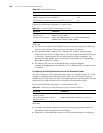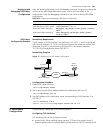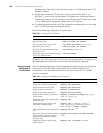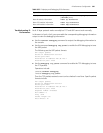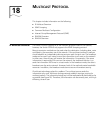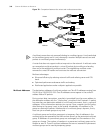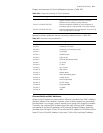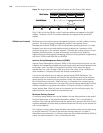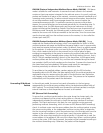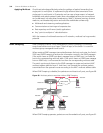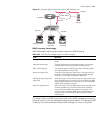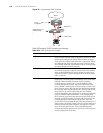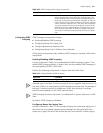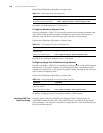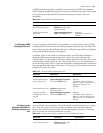
312 CHAPTER 18: MULTICAST PROTOCOL
Figure 79 Mapping between the multicast IP address and the Ethernet MAC address
Only 23 bits of the last 28 bits in the IP multicast address are mapped to the MAC
address. Therefore, the 32 IP multicast addresses are mapped to the same MAC
address.
IP Multicast Protocols Multicast uses the multicast group management protocol, and the multicast routing
protocol. The multicast group management protocol uses Internet Group
Management Protocol (IGMP) as the IP multicast basic signalling protocol. It is used
between hosts and routers and enables routers to determine if members of the
multicast group are on the network segment. The multicast routing protocol is used
between multicast routers to create and maintain multicast routes, enabling
highly-efficient multicast packet forwarding. Multicast routing protocols supported by
the Switch 5500 include PIM-SM and PIM-DM.
Internet Group Management Protocol (IGMP)
Internet Group Management Protocol (IGMP) is the only protocol that hosts can use.
It defines the membership establishment and maintenance mechanism between hosts
and routers, and is the basis of the entire IP multicast. Hosts report the group
membership to a router through IGMP and inform the router of the conditions of
other members in the group through the directly connected host.
If a user on the network joins a multicast group through IGMP declaration, the
multicast router on the network will transmit the information sent to the multicast
group through the multicast routing protocol. Finally, the network will be added to
the multicast tree as a branch. When the host, as a member of a multicast group,
begins receiving the information, the router will query the group periodically to check
whether members in the group are involved. As long as one host is involved, the
router receives data. When all users on the network quit the multicast group, the
related branches are removed from the multicast tree.
Multicast Routing Protocol
A multicast group address has a virtual address. Unicast allows packets to be routed
from the data source to the specified destination address. This is not possible for
multicast. The multicast application sends the packets to a group of receivers (as with
multicast addresses) who are ready to receive the data but not only to one receiver (as
with unicast address).
The multicast routing creates a loop-free data transmission path from one data source
to multiple receivers. The task of the multicast routing protocol is to create a
distribution tree architecture. A multicast router can use multiple methods to build up
a path for data transmission, that is, the distribution tree.
111
0
X
X
X
X
32 bits IP addr ess
48 bits MAC addr ess
5 bit s not mapped
Lower 23 bit s dir ect l y mapped
XXX
X
X
X
X
X
XXX
X
X
X
X
X
XXX
X
X
X
X
X
XXX
X
X
X
X
X
XXX
X
X
X
X
X
XXX
X
X
X
X
X
XXX
X
X
X
X
X
XXX
X
X
X
X
X
XXX
X
X
X
X
X



